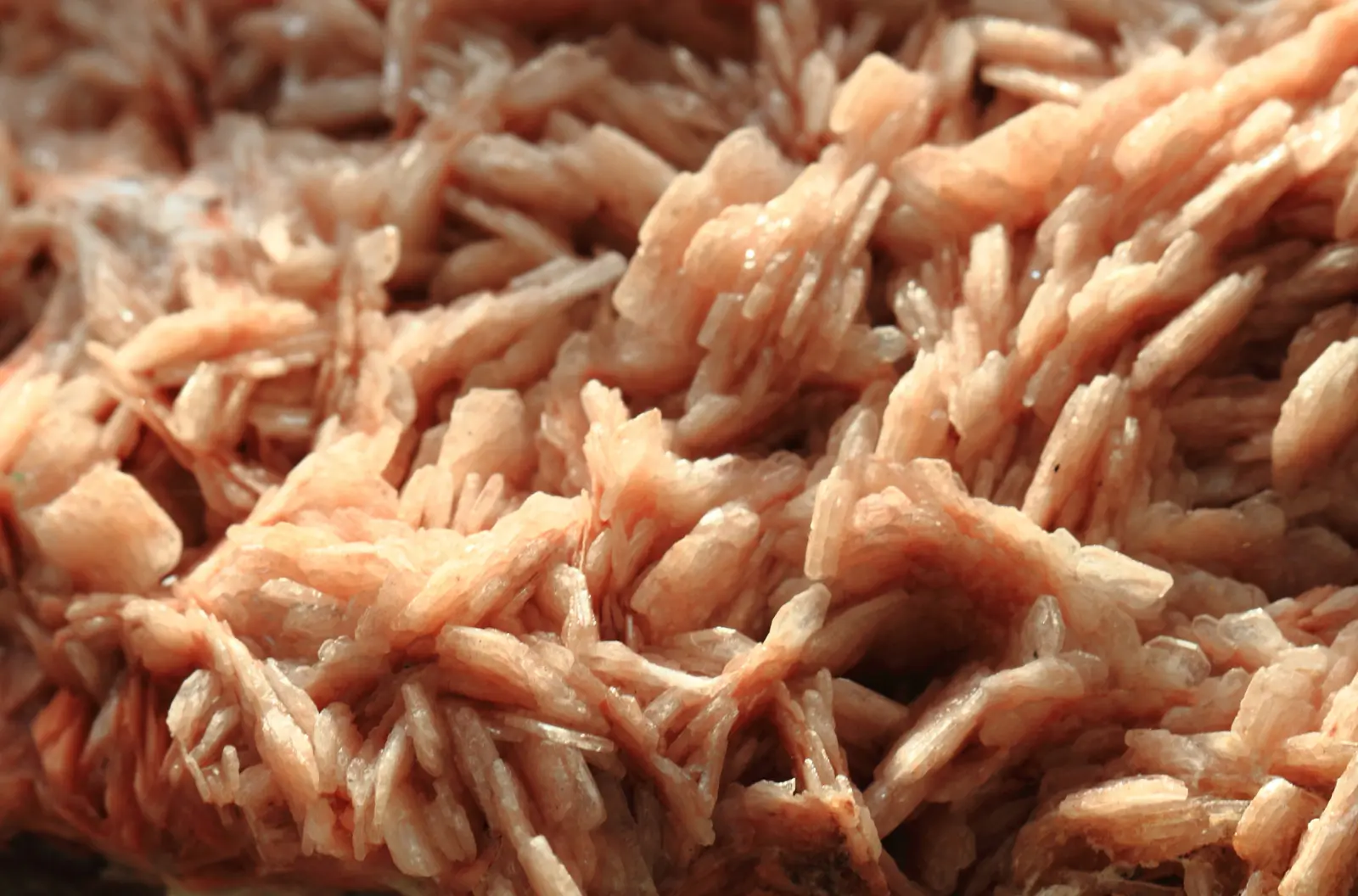TABLE OF CONTENTS
TABLE OF CONTENTS
What is Barite?
Barite, also known as baryte, is a naturally occurring mineral composed of barium sulfate (BaSO₄). It is a dense mineral with a high specific gravity, making it one of the heaviest non-metallic minerals. The name “barite” is derived from the Greek word “barys,” meaning heavy, due to its notable weight.
This mineral is found in various geological environments, typically in sedimentary rocks, hydrothermal veins, and as a byproduct of mining processes. Barite is often colorless or white, but it can also appear in shades of blue, yellow, red, and brown due to impurities. Its crystalline form ranges from tabular to prismatic crystals, often displaying a high degree of transparency and brilliance.
Barite’s primary industrial use is in the oil and gas industry, where it serves as a weighting agent in drilling fluids to prevent blowouts by maintaining pressure in the borehole. Additionally, it is used in the production of barium chemicals, as a filler in paints and plastics, and in medical applications as a radiocontrast agent for X-ray imaging.
Due to its significant weight and chemical properties, barite is a critical mineral in various industries, playing a crucial role in both industrial and medical applications.
Barite Definition
Barite is a mineral composed of barium sulfate (BaSO₄), known for its high specific gravity of around 4.5, making it one of the heaviest non-metallic minerals. It forms in hydrothermal veins and sedimentary rocks and can appear in various colors due to impurities. Barite is primarily used in the oil and gas industry as a weighting agent in drilling muds, helping to control pressure and prevent blowouts. It is also used in producing barium chemicals, as a filler in paints and plastics, and as a contrast agent in medical X-ray imaging.
Properties of Barite
Barite possesses several distinctive properties that make it valuable for various industrial applications. Here are the key properties of barite:
High Specific Gravity: Barite has a specific gravity of approximately 4.5, which is significantly higher than most other minerals. This high density is one of its most notable features, making it ideal as a weighting agent in drilling fluids for the oil and gas industry.
Chemical Composition: Barite is composed of barium sulfate (BaSO₄). Its chemical structure gives it stability and inertness, allowing it to be used in various chemical processes without reacting with other substances.
Crystal Structure: Barite has an orthorhombic crystal structure, often forming tabular or prismatic crystals. These crystals can be large and well-formed, adding to the mineral’s visual appeal.
Color: While barite is commonly colorless or white, it can also be found in shades of blue, yellow, red, and brown. These color variations are due to the presence of impurities such as iron, lead, or organic material.
Transparency and Luster: Barite can range from transparent to opaque, with a vitreous to resinous luster. This property makes it useful in the production of decorative items and as a gemstone in some instances.
Hardness: On the Mohs scale of hardness, barite ranks between 3 and 3.5. This relatively low hardness means it can be scratched by harder materials but is still durable enough for many industrial applications.
Solubility: Barite is insoluble in water and only slightly soluble in acids. This chemical inertness is crucial for its use in various applications, as it does not dissolve or react easily with other chemicals.
These properties collectively make barite a versatile and essential mineral in multiple industries, particularly in oil and gas exploration, chemical manufacturing, and medical imaging.
Types of Barite
Barite is classified into different types based on its composition, formation process, and physical characteristics. Here are the main types of barite:
Industrial Barite
Drilling Grade Barite: This type is primarily used in the oil and gas industry as a weighting agent in drilling muds. It is ground to a fine powder and added to drilling fluids to control pressure and prevent blowouts during drilling operations. Drilling grade barite must meet specific API (American Petroleum Institute) standards for density and purity.
Chemical Grade Barite
This type of barite is used in the production of barium chemicals, such as barium carbonate and barium chloride. It requires a high degree of purity and minimal contaminants to ensure the quality of the chemical products derived from it.
Paint and Coating Grade Barite
This type of barite is used as a filler in paints, coatings, and plastics. It enhances the density, brightness, and resistance to corrosion and weathering of the final product. Paint and coating grade barite must have a fine particle size and high whiteness.
Medical Grade Barite
Medical grade barite is used as a radiocontrast agent in medical imaging procedures such as X-rays and CT scans. It is ingested or injected into the body to improve the contrast of the images. This type of barite must be of the highest purity to be safe for human use.
Decorative Barite
Barite crystals are sometimes used in decorative items and as gemstones. These crystals can be clear or exhibit a range of colors, including blue, yellow, and brown, depending on the impurities present. Decorative barite is prized for its transparency and aesthetic appeal.
Mineral Specimens
Collectors and geologists often seek out barite mineral specimens for their unique and well-formed crystal structures. These specimens can be found in various geological settings and are valued for their beauty and rarity.
Each type of barite has specific characteristics and applications, making this mineral highly versatile and valuable across different industries.
How is Barite Formed?
Barite formation occurs through a variety of geological processes, leading to its presence in diverse environments. Here are the main ways barite is formed:
Sedimentary Processes: Barite commonly forms in sedimentary rocks through the precipitation of barium-rich fluids. This process often takes place in marine environments where barium ions combine with sulfate ions in seawater, leading to the crystallization of barite. These barite deposits can accumulate over time, forming substantial layers within the sedimentary rock strata.
Hydrothermal Processes: Hydrothermal barite formation occurs in veins and cavities within rocks, often associated with volcanic activity. Hot, mineral-rich fluids from deep within the Earth’s crust travel through fractures and fissures, depositing barite as the temperature and pressure conditions change. These hydrothermal veins can produce high-purity barite crystals, which are often well-formed and visually appealing.
Residual Deposits: Residual barite deposits form through the weathering and decomposition of barium-bearing rocks. As these rocks break down, barite remains as a residual mineral due to its resistance to chemical and physical weathering. These deposits are typically found in soil and regolith overlying the parent rock.
Biogenic Processes: Some barite formations are linked to biological activity, particularly in marine settings. Certain microorganisms can mediate the precipitation of barite from seawater, contributing to the formation of barite-rich sediments. These biogenic processes can play a significant role in barite accumulation in oceanic environments.
Chemical Precipitation: In some cases, barite forms directly from chemical precipitation in evaporative environments such as salt flats and playas. In these settings, water evaporates, leaving behind concentrated barium and sulfate ions that combine to form barite crystals. This type of formation is less common but can contribute to significant deposits in specific locations.
The formation of barite is influenced by a combination of geological, chemical, and biological factors. Its occurrence in various geological settings underscores its versatility and the diverse conditions under which it can form. These processes result in the formation of barite deposits that are mined and utilized for various industrial and medical applications.
What is Barite Used For?
Barite is a versatile mineral with a wide range of uses across various industries. Here are the primary applications of barite:
Oil and Gas Industry
The most significant use of barite is as a weighting agent in drilling fluids or muds. During the drilling of oil and gas wells, barite is added to the drilling mud to increase its density, which helps control the pressure in the borehole and prevent blowouts. This application requires barite of high purity and specific gravity to ensure effective pressure control.
Chemical Industry
Barite is used in the production of various barium compounds, such as barium carbonate, barium chloride, and barium hydroxide. These chemicals are used in a variety of applications, including the manufacturing of ceramics, glass, rubber, and electronics. Barite’s high purity is crucial for producing high-quality barium chemicals.
Medical Field
In the medical field, barite is used as a radiocontrast agent for X-ray imaging and other diagnostic procedures. It is ingested or administered as a suspension, providing a clear contrast on X-ray images of the digestive system. This helps doctors diagnose and monitor various conditions. Medical-grade barite must meet stringent purity standards to ensure patient safety.
Paints and Coatings
Barite is used as a filler and extender in paints, coatings, and plastics. Its high density and brightness enhance the properties of these products, providing better coverage, durability, and resistance to weathering. Barite also improves the smoothness and stability of paint formulations.
Rubber and Plastics
In the rubber and plastics industries, barite acts as a filler to improve product strength, durability, and resistance to abrasion. It helps reduce costs by replacing more expensive resins and polymers while maintaining the desired physical properties of the end products.
Automotive Industry
Barite is used in the automotive industry as a filler in brake pads, clutch pads, and other friction materials. Its high density and thermal stability make it an excellent material for enhancing the performance and lifespan of these components.
Glass and Ceramics
Barite is used in the manufacturing of glass and ceramics. In glassmaking, it acts as a flux to reduce melting temperatures and improve the quality of the glass. In ceramics, barite is used to enhance the strength and durability of the final products.
Radiation Shielding
Due to its high density, barite is used in radiation shielding materials. It is incorporated into concrete and other shielding products to protect against harmful radiation in medical, industrial, and nuclear applications.
These diverse uses of barite highlight its importance as an industrial mineral. Its unique properties make it indispensable in various applications, from oil drilling to medical diagnostics and beyond.
Conclusion
Barite is a remarkable mineral with diverse applications across several industries. Its high specific gravity, chemical inertness, and versatile properties make it indispensable in the oil and gas industry as a weighting agent in drilling fluids. Barite is also crucial in the production of barium chemicals, paints, plastics, and friction materials for the automotive industry. In the medical field, barite serves as a radiocontrast agent for X-ray imaging. Additionally, its use in glass, ceramics, and radiation shielding further underscores its significance. Understanding the properties, types, formation processes, and uses of barite provides valuable insights into its essential role in modern industry and healthcare, making it a critical mineral for various technological advancements.
FAQs about Barite
What is the mineral group for barite?
Barite belongs to the sulfate mineral group.
Where is barite found in the world?
Barite is found worldwide, with significant deposits in China, India, the United States, Morocco, and Mexico.
What is the density of barite?
The density of barite is approximately 4.5 grams per cubic centimeter.
Barite hardness
Barite has a hardness of 3 to 3.5 on the Mohs scale.
Chemical formula of barite
The chemical formula of barite is BaSO₄ (barium sulfate).
Barite color
Barite can be colorless, white, blue, yellow, red, or brown, depending on impurities.
Blue barite metaphysical properties
Blue barite is believed to enhance communication and mental clarity, providing a calming effect and promoting spiritual growth.
Contact Us
Questions or looking for a quote?





